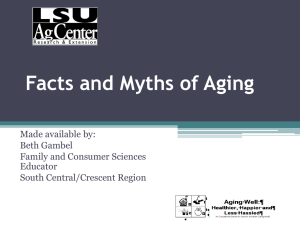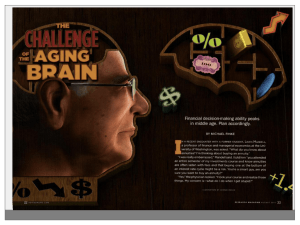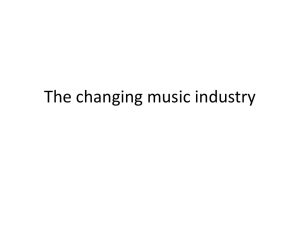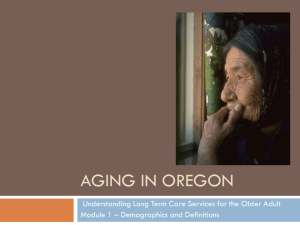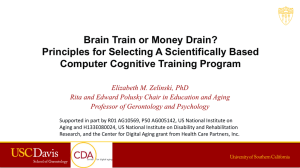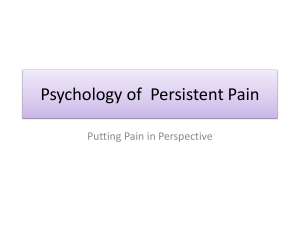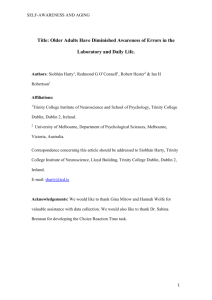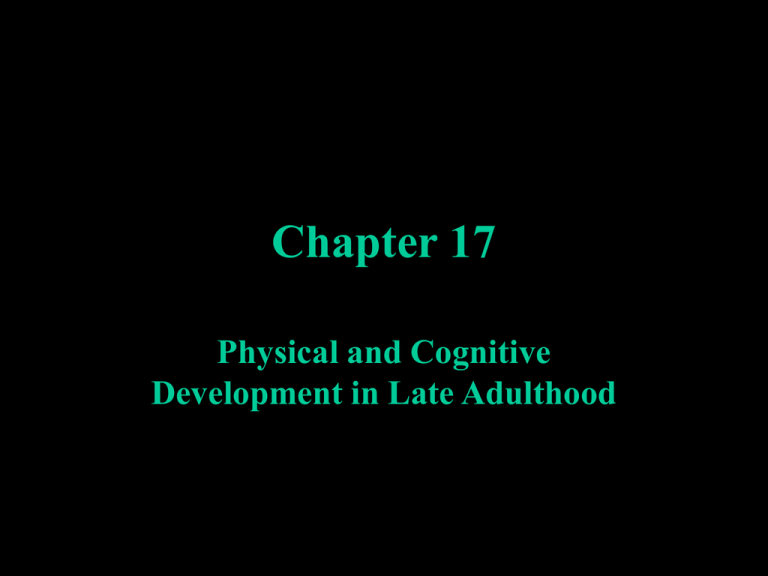
Chapter 17
Physical and Cognitive
Development in Late Adulthood
Ageism- prejudice or discrimination based on age
• Longer life spans due to healthier life styles,
improved medicine, safer food and water,
economic growth
Primary aging- gradual inevitable process of bodily
deterioration that begins in early life and
continues.
Secondary aging- results from disease, abuse,
disuse- factors within control of the individual
Functional age- how well a person functions in a
physical and environment compared to
chronological age
Gerontology- study of the aged and aging
process
Longevity & Life
Life expectancy- age to which a person born
at a certain time and place is statistically
likely to live, given current age and health
status; It is the average of longevity (actual
length of life
Life span- entire life process
Trends
Women typically outlive men
Senescene- period of obvious marked declines in
body functioning associated with aging
Genetic programming theories hold that body’s age
according to a normal developmental timetable
that is genetic
Programmed senescene- specific genes switching
off
Biological clock- acts through genes that control
hormonal changes or cause problems in the
immune system
Telomeres- protective tips of chromosomes, shorten
each time the cell divides
Chronic disorders tend to occur in those with shorter
telomeres and lower levels of telomerase (enzyme
that enables sex chromosomes to repair their
telomeres, typically change in older women
Evolutionary theory of aging- reproductive fitness is
the primary aim of natural selection and no
reproductive purpose is served by putting genetic
resources into life beyond reproductive age.
Variable-rate theories- (error theories), view ageing
as a result of random processes that vary from
person to person; aging involves damage due to
chance errors in, or environmental assaults on,
biological systems. Some theories focus on
internal processes such as metabolism (process by
which the body turns food and oxygen into
energy)
Wear-and-tear theory- holds that the body ages as a
result of accumulated damage to the system at the
molecular level. As people age, they are less able
to repair or replace damaged parts.
Free-radical theories- focuses on harmful effects of
free radicals- highly unstable oxygen atoms or
molecules formed during metabolism, which react
to damaged cell membranes, cell proteins, fats,
carbohydrates, and DNA. Such damage is related
to arthritis, muscular dystrophy, cataracts, cancer,
late-onset diabetes, and neurological disorders
such as Parkinson’s.
Rate-of-living theory holds that the body can do just
so much work; the faster it works, the more energy
it uses, the faster it wears out. Speed of
metabolism (energy use) determines length of life.
Autoimmune theory suggests that an ageing immune
system can become confused and release
antibodies that attack the body’s own cells.
This malfunction is called autoimmunity, thought to
be responsible for some aging-related diseases and
disorders. This is normally genetically
regulated/programmed.
When mechanisms for destruction of unneeded cells
malfunction, a breakdown in cell clean-out can
lead to stroke damage, Alzheimer’s, cancer, or
autoimmune disease; also can cause the death of
needed cells.
Current theory incorporating both evolutionary and
variable-rate theories (Hayflick) is that natural
selection has resulted in energy resources
sufficient only to maintain the body until
reproduction. After reproduction, insufficient
energy lest to continue to maintain the molecular
integrity of body cells and systems, deteriorating
randomly beyond the body’s capacity to repair
them, increasing vulnerability to disease and
death.
Survival curves- percentages of people who live to
various ages
Hayflick limit- human cells divide in the lab
only 50 times. Limit therefore is 110 years.
One rate-of-living theory views that the speed
of metabolism (energy used), is the crucial
determinate of aging, is dietary restriction.
Physical Changes
• Skins becomes paler, less elastic, wrinkles,
varicose veins, fat and muscle shrink.
• Become shorter as spinal disks atrophy
Organic & Systemic Changes
• Aging and chronic stress can depress the immune
system, making more susceptible to infections and
less likely to ward them off.
• Digestive tract remains relatively efficient.
• Heart- becomes slower and more irregular
• Deposits of fat accumulate around the heart- may
interfere with functioning
• Reserve capacity- (organ reserve), a backup
capacity that helps the body systems function in
times of stress, decreases; therefore more
susceptible to effects of stress
The Aging Brain
• Modest changes in the healthy brain.
• Loss of neurons (nerve cells) in the cerebral
cortex (handles most cognitive tasks)
• Shrinkage in neural size due to loss of
connective tissue (axons, dendrites, synapses)
• Frontal cortex is first (memory and high-level
cognitive functioning)
• Loss of brain matter may come slowly in the
central nervous system.
• Lesions in the white matter of axons (usually
due to hypertension) can reduce performance.
Cerebral cortex shrinkage faster in men. Early
for women who are obese.
Education (related factors, high income, less
disability) may increase brain’s reserve/capacity
to tolerate potentially injurious effects of aging;
aerobic exercise can slow brain tissue loss; diet
heavy in fruits and vegetables can retard or reverse
age-related declines in brain functioning.
Older brains can grow new nerve cells, once thought
impossible. Especially in the hippocampus
(learning and memory)
Sensory & Psychomotor Functioning
• Differences with age.
• Better aids to help overcome disabling diseases
and disorders (Table 17-2; page 641)
Vision & Hearing
• Difficulty with depth and color perception
(reading, activities, etc)
• More sensitive to glare, trouble locating signs,
driving becomes dangerous
• Some times glasses can help
Cataracts- age-related macular degeneration,
glaucoma, diabetic retinopathy
Age-related degeneration- center of retina
gradually loses ability to sharply distinguish
fine details, is leading cause of impairment
Glaucoma- irreversible damage to optic nerve
caused by increased pressure in the eye, can
result in blindness
Strength, endurance, balance, reaction time
• Lose about 10-20% of strength by age 70
and increases after that
• Walking endurance declines, flexibility for
women declines, muscle strength and power
may decrease.
Plasticity- Some losses are partially reversible
(weight & power training, resistance
training, spontaneous physical activity; lowimpact, moderately-intense aerobic dance
and exercise training can peak oxygen
uptake, leg muscle strength, and vigor.
Why more susceptible to falls- reduced
sensitivity to receptor cells that give brain
information on body’s position in space
(spatial ability). Slower reflexes and
impaired depth perception also factors.
Sleep
Tend to sleep less and dream less, les deep sleep
Sexual functioning
Most remains consistent in sexual activity over the
years.
Men: longer to develop erection and to ejaculate,
may need more manual stimulation, longer
refractory periods. Erectile dysfunction may
increase.
Women: breasts engorgement and other sexual
arousal signs less intense; vagina may become less
flexible and need lubrication.
Physical & Mental Health
Many remaining healthier today.
Chronic conditions & disabilities
• 80% have chronic conditions, 50% have
two.
• About 50% of those over 85, frail,
vulnerable to stress, disease, disability,
death
Common chronic conditions
• Heart disease, cancer, stroke, chronic lower
respiratory disease
• 60% all death- stroke, heart disease, cancer
• hypertension (50%) and diabetes (16%) increasing
• hypertension related to cognitive declines in
attention, learning, memory, executive functions,
psychomotor abilities; visual, perceptual, and
spatial skills
• women more likely to have: hypertension, asthma,
chronic bronchitis, arthritic symptoms
• men more likely to have: heart disease, cancer,
diabetes, emphysema
Common chronic conditions
• activities of daily living (ADLs) 10% have
difficulty carrying out
• physical activity- strengthens the heart and
lungs and decreases stress
• inactivity- contributes to heart disease,
diabetes, colon cancer, high blood pressure,
obesity- which affects circulatory system,
kidneys, sugar metabolism- contributes to
degenerative disorders and shortens life
Common chronic conditions
• nutrition- 81% report bad diets
• plays significant role in chronic illnesses
• loss of teeth- due to infrequent dental care
Mental & Behavioral Problems
Less frequent
Depression- 11% men; 18% women
Heredity accounts for 50%
Dementia- physiologically caused cognitive
and behavioral decline sufficient to interfere
with daily activities
Education and large head size seem to be
protective against depression
Alzheimer’s disease- most common and
feared terminal illnesses
• Memory impairment, deterioration of
language, deficits in visual and spatial
processing
• Personality changes- rigid, apathy,
egocentricity, impaired emotional control;
depression, anxiety, poor judgment and
problem solving, anxiety, delusions and
delirium later.
Alzheimer’s disease• Accumulation of protein called beta
amyloid peptide
• Contains excessive amounts of
neurofubrillary tangles (twisted masses of
dead neurons) and large waxy clumps of
amyloid plaque (nonfunctioning tissue
formed by beta amyloid in spaces between
neurons). These become dense, spread, and
destroy surrounding neurons.
Alzheimer’s disease• Cognitive reserve- may enable deteriorating
brain to continue to function under stress.
Diet, exercise, lifestyle factors play a role in
prevention. Vitamin E, n-e fatty acids,
unhydrogenated unsaturated fats, oil-based
dressings, nuts, seeds, fish, mayonnaise,
eggs. Opposite foods encourage it. Possibly
sleep apnea and head injury early in life
may also cause it.
Cognitive Development
Intelligence: abilities such as speed of mental
processes and abstract reasoning may decline,
others tend to improve.
Fluid intelligence- ability to solve problems that
require little or no previous knowledge
Declines earlier in life though not necessarily to
impact in later life. May not decline as much as
once thought.
Crystallize intelligence- ability to remember and use
information acquired over lifetime
Improves until late in life, even in later life
Memory
Short-term memory
• Sensory memory- retains efficiency
throughout life
• Working memory- gradually shrinks after
age 45
• Tasks that require rehearsal or repetition
decline little
• Tasks that require reorganization or
elaboration shower greater decline
Memory
Long-term memory
Episodic memory- (recently stored memoryrecent events) deteriorates with age
Semantic memory- (stored knowledge of
historical facts, customs, locations,
meanings of words) not dependent on
remembering when/where something was
learned, shows little decline with age
Memory
Long-term memory
Procedural memory- (knowledge of how to
do something- motor skills, habits, without
conscious effort) relatively unaffected by
age though slower responses.
Priming- memory that is unconscious, ability
to problem solve, answer a question, do a
task, identify a picture or recall familiar
word- declines little.
Speech and memory
Better than young people in remembering a word.
But more difficulty coming up with the word if
given the definition.
Why memory problems
• Less efficient in encoding new information
• Some storage memory may deteriorate to point
where retrieval becomes difficult or impossible
• Traces of decayed memories are likely to remain,
possible to reconstruct them or at least to relearn
the material
• Takes longer to recall.
Neurological changes
Hippocampus- critical to ability to store new
information in episodic memory, loses about 20%
of nerve cells with advancing age
Unconscious learning- apparently independent of
the hippocampus, is less affected; recall of prior
learning, may increase.
Frontal lobes- involved in encoding and retrieval of
episodic memories; dysfunction may cause false
memories
Neurological changes
Early decline in frontal cortex, which is essential for
working memory, may be cause of inability to
concentrate or pay attention and difficulty in
performing a task of several steps.
Brain often compensates for age-related declines,
using both left and right hemispheres versus
younger people only using one hemisphere at a
time.
May be able to recover some lost memory and to
improve memory, especially in fluid memory.
Using previously neglected or unused abilities
helps.

